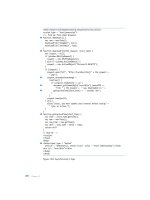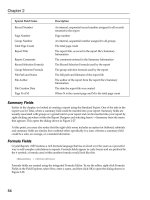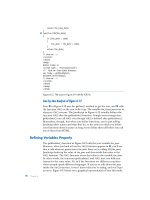Programming C# 2nd Edition phần 3 ppsx
Bạn đang xem bản rút gọn của tài liệu. Xem và tải ngay bản đầy đủ của tài liệu tại đây (925.17 KB, 59 trang )
Programming C#, 2nd Edition
113
public class Tester
{
static void Main( )
{
Fraction f1 = new Fraction(3,4);
Console.WriteLine("f1: {0}", f1.ToString( ));
Fraction.FractionArtist fa = new Fraction.FractionArtist( );
fa.Draw(f1);
}
}
The nested class is shown in bold. The FractionArtist class provides only a single member,
the Draw( ) method. What is particularly interesting is that Draw( ) has access to the private
data members f.numerator and f.denominator, to which it would not have had access if it
were not a nested class.
Notice in Main( ) that to declare an instance of this nested class, you must specify the type
name of the outer class:
Fraction.FractionArtist fa = new Fraction.FractionArtist( );
FractionArtist
is scoped to within the Fraction class.
Programming C#, 2nd Edition
114
Chapter 6. Operator Overloading
It is a design goal of C# that user-defined classes have all the functionality of built-in types.
For example, suppose you have defined a type to represent fractions. Ensuring that this class
has all the functionality of the built-in types means that you must be able to perform
arithmetic on instances of your fractions (e.g., add two fractions, multiply, etc.) and convert
fractions to and from built-in types such as integer (int). You could, of course, implement
methods for each of these operations and invoke them by writing statements such as:
Fraction theSum = firstFraction.Add(secondFraction);
Although this will work, it is ugly and not how the built-in types are used. It would be much
better to write:
Fraction theSum = firstFraction + secondFraction;
Statements like this are intuitive and consistent with how built-in types, such as int, are
added.
In this chapter you will learn techniques for adding standard operators to your user-defined
types. You will also learn how to add conversion operators so that your user-defined types can
be implicitly and explicitly converted to other types.
6.1 Using the operator Keyword
In C#, operators are static methods whose return values represent the result of an operation
and whose parameters are the operands. When you create an operator for a class you say you
have "overloaded" that operator, much as you might overload any member method. Thus, to
overload the addition operator (+) you would write:
public static Fraction operator+(Fraction lhs, Fraction rhs)
It is my convention to name the parameters lhs and rhs. The parameter name lhs stands for
"lefthand side" and reminds me that the first parameter represents the lefthand side of the
operation. Similarly,
rhs stands for "righthand side."
The C# syntax for overloading an operator is to write the word
operator followed by the
operator to overload. The operator keyword is a method modifier. Thus, to overload the
addition operator (+), write operator+.
When you write:
Fraction theSum = firstFraction + secondFraction;
the overloaded + operator is invoked, with the first Fraction passed as the first argument, and
the second
Fraction passed as the second argument. When the compiler sees the expression:
firstFraction + secondFraction
it translates that expression into:
Programming C#, 2nd Edition
115
Fraction.operator+(firstFraction, secondFraction)
The result is that a new Fraction is returned, which in this case is assigned to the Fraction
object named theSum.
C++ programmers take note: it is not possible to create nonstatic
operators, and thus binary operators must take two operands.
6.2 Supporting Other .NET Languages
C# provides the ability to overload operators for your classes, even though this is not, strictly
speaking, in the Common Language Specification (CLS). Other .NET languages, such as
VB.NET, might not support operator overloading, and it is important to ensure that your class
supports the alternative methods that these other languages might call to create the same
effect.
Thus, if you overload the addition operator (
+), you might also want to provide an add( )
method that does the same work. Operator overloading ought to be a syntactic shortcut, not
the only path for your objects to accomplish a given task.
6.3 Creating Useful Operators
Operator overloading can make your code more intuitive and enable it to act more like
the built-in types. It can also make your code unmanageable, complex, and obtuse if you
break the common idiom for the use of operators. Resist the temptation to use operators in
new and idiosyncratic ways.
For example, although it might be tempting to overload the increment operator (++) on
an employee class to invoke a method incrementing the employee's pay level, this can create
tremendous confusion for clients of your class. It is best to use operator overloading
sparingly, and only when its meaning is clear and consistent with how the built-in classes
operate.
6.4 Logical Pairs
It is quite common to overload the equals operator (==) to test whether two objects are equal
(however equality might be defined for your object). C# insists that if you overload the equals
operator, you must also overload the not-equals operator (!= ). Similarly, the less-than (<) and
greater-than (>) operators must be paired, as must the less-than or equals (<=) and greater-than
or equals (>=) operators.
6.5 The Equals Operator
If you overload the equals operator (==), it is recommended that you also override the virtual
Equals( ) method provided by object and route its functionality back to the equals
operator. This allows your class to be polymorphic and provides compatibility with other
.NET languages that do not overload operators (but do support method overloading). The FCL
Programming C#, 2nd Edition
116
classes will not use the overloaded operators but will expect your classes to implement the
underlying methods. Thus, for example, ArrayList expects you to implement Equals( ).
The object class implements the Equals( ) method with this signature:
public override bool Equals(object o)
By overriding this method, you allow your Fraction class to act polymorphically with all
other objects. Inside the body of Equals( ), you will need to ensure that you are comparing
with another Fraction, and if so you can pass the implementation along to the equals
operator definition that you've written.
public override bool Equals(object o)
{
if (! (o is Fraction) )
{
return false;
}
return this == (Fraction) o;
}
The is operator is used to check whether the runtime type of an object is compatible with the
operand (in this case, Fraction). Thus o is Fraction will evaluate true if o is in fact a type
compatible with Fraction.
6.6 Conversion Operators
C# converts int to long implicitly, and allows you to convert long to int explicitly. The
conversion from int to long is implicit because you know that any int will fit into the
memory representation of a long. The reverse operation, from long to int, must be explicit
(using a cast) because it is possible to lose information in the conversion:
int myInt = 5;
long myLong;
myLong = myInt; // implicit
myInt = (int) myLong; // explicit
You must have the same functionality for your fractions. Given an int, you can support an
implicit conversion to a fraction because any whole value is equal to that value over 1 (e.g.,
15==15/1).
Given a fraction, you might want to provide an explicit conversion back to an integer,
understanding that some value might be lost. Thus, you might convert 9/4 to the integer
value 2.
The keyword implicit is used when the conversion is guaranteed to succeed and no
information will be lost; otherwise explicit is used.
Example 6-1 illustrates how you might implement implicit and explicit conversions, and some
of the operators of the Fraction class. (Although I've used Console.WriteLine to print
messages illustrating which method we're entering, the better way to pursue this kind of trace
is with the debugger. You can place a breakpoint on each of the test statements, and then step
Programming C#, 2nd Edition
117
into the code, watching the invocation of the constructors as they occur.) When you compile
this example, it will generate some warnings because GetHashCode( ) is not implemented
(see Chapter 9).
Example 6-1. Defining conversions and operators for the fraction class operators
using System;
public class Fraction
{
public Fraction(int numerator, int denominator)
{
Console.WriteLine("In Fraction Constructor(int, int)");
this.numerator=numerator;
this.denominator=denominator;
}
public Fraction(int wholeNumber)
{
Console.WriteLine("In Fraction Constructor(int)");
numerator = wholeNumber;
denominator = 1;
}
public static implicit operator Fraction(int theInt)
{
System.Console.WriteLine("In implicit conversion to Fraction");
return new Fraction(theInt);
}
public static explicit operator int(Fraction theFraction)
{
System.Console.WriteLine("In explicit conversion to int");
return theFraction.numerator /
theFraction.denominator;
}
public static bool operator==(Fraction lhs, Fraction rhs)
{
Console.WriteLine("In operator ==");
if (lhs.denominator == rhs.denominator &&
lhs.numerator == rhs.numerator)
{
return true;
}
// code here to handle unlike fractions
return false;
}
public static bool operator !=(Fraction lhs, Fraction rhs)
{
Console.WriteLine("In operator !=");
return !(lhs==rhs);
}
Programming C#, 2nd Edition
118
public override bool Equals(object o)
{
Console.WriteLine("In method Equals");
if (! (o is Fraction) )
{
return false;
}
return this == (Fraction) o;
}
public static Fraction operator+(Fraction lhs, Fraction rhs)
{
Console.WriteLine("In operator+");
if (lhs.denominator == rhs.denominator)
{
return new Fraction(lhs.numerator+rhs.numerator,
lhs.denominator);
}
// simplistic solution for unlike fractions
// 1/2 + 3/4 == (1*4) + (3*2) / (2*4) == 10/8
int firstProduct = lhs.numerator * rhs.denominator;
int secondProduct = rhs.numerator * lhs.denominator;
return new Fraction(
firstProduct + secondProduct,
lhs.denominator * rhs.denominator
);
}
public override string ToString( )
{
String s = numerator.ToString( ) + "/" +
denominator.ToString( );
return s;
}
private int numerator;
private int denominator;
}
public class Tester
{
static void Main( )
{
Fraction f1 = new Fraction(3,4);
Console.WriteLine("f1: {0}", f1.ToString( ));
Fraction f2 = new Fraction(2,4);
Console.WriteLine("f2: {0}", f2.ToString( ));
Fraction f3 = f1 + f2;
Console.WriteLine("f1 + f2 = f3: {0}", f3.ToString( ));
Fraction f4 = f3 + 5;
Console.WriteLine("f3 + 5 = f4: {0}", f4.ToString( ));
Programming C#, 2nd Edition
119
Fraction f5 = new Fraction(2,4);
if (f5 == f2)
{
Console.WriteLine("F5: {0} == F2: {1}",
f5.ToString( ),
f2.ToString( ));
}
}
}
The Fraction class begins with two constructors. One takes a numerator and denominator,
the other takes a whole number. The constructors are followed by the declaration of two
conversion operators. The first conversion operator changes an integer into a Fraction:
public static implicit operator Fraction(int theInt)
{
return new Fraction(theInt);
}
This conversion is marked implicit because any whole number (int) can be converted to a
Fraction by setting the numerator to the int and the denominator to 1. Delegate this
responsibility to the constructor that takes an int.
The second conversion operator is for the explicit conversion of Fractions into integers:
public static explicit operator int(Fraction theFraction)
{
return theFraction.numerator /
theFraction.denominator;
}
Because this example uses integer division, it will truncate the value. Thus, if the fraction is
15/16, the resulting integer value will be 1. A more sophisticated conversion operator might
accomplish rounding.
The conversion operators are followed by the equals operator (==) and the not equals operator
(
!=). Remember that if you implement one of these equals operators, you must implement
the other.
You have defined value equality for a
Fraction such that the numerators and denominators
must match. For this exercise, 3/4 and 6/8 are not considered equal. Again, a more
sophisticated implementation would reduce these fractions and notice the equality.
Include an override of the object class' Equals( ) method so that your Fraction objects can
be treated polymorphically with any other object. Your implementation is to delegate
the evaluation of equality to the equality operator.
A Fraction class would, no doubt, implement all the arithmetic operators (addition,
subtraction, multiplication, division). To keep the illustration simple, implement only
addition, and even here you simplify greatly. Check to see if the denominators are the same; if
so, add the following numerators:
Programming C#, 2nd Edition
120
public static Fraction operator+(Fraction lhs, Fraction rhs)
{
if (lhs.denominator == rhs.denominator)
{
return new Fraction(lhs.numerator+rhs.numerator,
lhs.denominator);
}
If the denominators are not the same, cross multiply:
int firstProduct = lhs.numerator * rhs.denominator;
int secondProduct = rhs.numerator * lhs.denominator;
return new Fraction(
firstProduct + secondProduct,
lhs.denominator * rhs.denominator
This code is best understood with an example. If you were adding 1/2 and 3/4, you can
multiply the first numerator (1) by the second denominator (4) and store the result (4) in
firstProduct. You can also multiply the second numerator (3) by the first denominator (2)
and store that result (6) in secondProduct. You add these products (6+4) to a sum of 10,
which is the numerator for the answer. You then multiply the two denominators (2*4) to
generate the new denominator (8). The resulting fraction (10/8) is the correct answer.
1
Finally, to enable debugging of the new Fraction class, the code is written so that Fraction
is able to return its value as a string in the format numerator/denominator:
public override string ToString( )
{
String s = numerator.ToString( ) + "/" +
denominator.ToString( );
return s;
}
Create a new string object by calling the ToString( ) method on numerator. Since
numerator is an int, and ints are value types, the call to the ToString() method causes the
compiler to implicitly box the integer (creating an object) and calls ToString( ) on that
object, returning a string representation of the numerator. Concatenate the string "/" and then
concatenate the string that results from calling ToString( ) on the denominator.
With your Fraction class in hand, you're ready to test. Your first tests create simple
fractions, 3/4 and 2/4:
Fraction f1 = new Fraction(3,4);
Console.WriteLine("f1: {0}", f1.ToString( ));
Fraction f2 = new Fraction(2,4);
Console.WriteLine("f2: {0}", f2.ToString( ));
The output from this is what you would expect the invocation of the constructors and the
value printed in WriteLine:
1
To recap: 1/2=4/8, 3/4=6/8, 4/8+6/8=10/8. The example does not reduce the fraction, to keep it simple.
Programming C#, 2nd Edition
121
In Fraction Constructor(int, int)
f1: 3/4
In Fraction Constructor(int, int)
f2: 2/4
The next line in Main( ) invokes the static operator+. The purpose of this operator is to add
two fractions and return the sum in a new fraction:
Fraction f3 = f1 + f2;
Console.WriteLine("f1 + f2 = f3: {0}", f3.ToString( ));
Examining the output reveals how operator+ works:
In operator+
In Fraction Constructor(int, int)
f1 + f2 = f3: 5/4
The operator+ is invoked, and then the constructor for f3, taking the two int values
representing the numerator and denominator of the resulting new fraction.
The next test in Main( ) adds an int to the Fraction f3 and assigns the resulting value to
a new Fraction, f4:
Fraction f4 = f3 + 5;
Console.WriteLine("f3 + 5: {0}", f4.ToString( ));
The output shows the steps for the various conversions:
In implicit conversion to Fraction
In Fraction Constructor(int)
In operator+
In Fraction Constructor(int, int)
f3 + 5 = f4: 25/4
Notice that the implicit conversion operator was invoked to convert 5 to a fraction. In the
return statement from the implicit conversion operator, the
Fraction constructor was called,
creating the fraction
5/1. This new fraction was then passed along with Fraction f3 to
operator+, and the sum was passed to the constructor for f4.
In our final test, a new fraction (f5) is created. Test whether it is equal to f2. If so, print their
values:
Fraction f5 = new Fraction(2,4);
if (f5 == f2)
{
Console.WriteLine("F5: {0} == F2: {1}",
f5.ToString( ),
f2.ToString( ));
}
The output shows the creation of f5, and then the invocation of the overloaded equals
operator:
Programming C#, 2nd Edition
122
In Fraction Constructor(int, int)
In operator ==
F5: 2/4 == F2: 2/4
Programming C#, 2nd Edition
123
Chapter 7. Structs
A struct is a simple user-defined type, a lightweight alternative to classes. Structs are similar
to classes in that they may contain constructors, properties, methods, fields, operators, nested
types and indexers (see Chapter 9).
There are also significant differences between classes and structs. For instance, structs don't
support inheritance or destructors. More important, although a class is a reference type,
a struct is a value type. (See Chapter 3 for more information about classes and types.) Thus,
structs are useful for representing objects that do not require reference semantics.
The consensus view is that you ought to use structs only for types that are small, simple, and
similar in their behavior and characteristics to built-in types.
Structs are somewhat more efficient in their use of memory in arrays (see Chapter 9).
However, they can be less efficient when used in collections. Collections expect references,
and structs must be boxed. There is overhead in boxing and unboxing, and classes might be
more efficient in large collections.
In this chapter, you will learn how to define and work with structs and how to use
constructors to initialize their values.
7.1 Defining Structs
The syntax for declaring a struct is almost identical to that for a class:
[attributes] [access-modifiers] struct identifier [:interface-list]
{ struct-members }
Example 7-1 illustrates the definition of a struct. Location represents a point on a two-
dimensional surface. Notice that the struct Location is declared exactly as a class would be,
except for the use of the keyword struct. Also notice that the Location constructor takes
two integers and assigns their value to the instance members, x and y. The x and y coordinates
of Location are declared as properties.
Example 7-1. Creating a struct
using System;
public struct Location
{
public Location(int xCoordinate, int yCoordinate)
{
xVal = xCoordinate;
yVal = yCoordinate;
}
Programming C#, 2nd Edition
124
public int x
{
get
{
return xVal;
}
set
{
xVal = value;
}
}
public int y
{
get
{
return yVal;
}
set
{
yVal = value;
}
}
public override string ToString( )
{
return (String.Format("{0}, {1}", xVal,yVal));
}
private int xVal;
private int yVal;
}
public class Tester
{
public void myFunc(Location loc)
{
loc.x = 50;
loc.y = 100;
Console.WriteLine("Loc1 location: {0}", loc);
}
static void Main( )
{
Location loc1 = new Location(200,300);
Console.WriteLine("Loc1 location: {0}", loc1);
Tester t = new Tester( );
t.myFunc(loc1);
Console.WriteLine("Loc1 location: {0}", loc1);
}
}
Output
Loc1 location: 200, 300
In MyFunc loc: 50, 100
Loc1 location: 200, 300
Unlike classes, structs do not support inheritance. They implicitly derive from object (as do
all types in C#, including the built-in types) but cannot inherit from any other class or struct.
Structs are also implicitly sealed (that is, no class or struct can derive from a struct). Like
Programming C#, 2nd Edition
125
classes, however, structs can implement multiple interfaces. Additional differences include
the following:
No destructor or custom default constructor
Structs cannot have destructors, nor can they have a custom parameterless (default)
constructor. If you do not supply a constructor, your struct will in effect be provided
with a default constructor that will zero all the data members or set them to default
values appropriate to their type (see Table 4-2). If you supply any constructor, you
must initialize all the fields in the struct.
No initialization
You cannot initialize an instance field in a struct. Thus, it is illegal to write:
private int xVal = 50;
private int yVal = 100;
though that would have been fine had this been a class.
Structs are designed to be simple and lightweight. While private member data promotes data
hiding and encapsulation, some programmers feel it is overkill for structs. They make the
member data public, thus simplifying the implementation of the struct. Other programmers
feel that properties provide a clean and simple interface, and that good programming practice
demands data hiding even with simple lightweight objects. Whichever you choose is a matter
of design philosophy; the language supports either approach.
7.2 Creating Structs
Create an instance of a struct by using the new keyword in an assignment statement, just as
you would for a class. In Example 7-1, the Tester class creates an instance of Location as
follows:
Location loc1 = new Location(200,300);
Here the new instance is named loc1 and is passed two values, 200 and 300.
7.2.1 Structs as Value Types
The definition of the
Tester class in Example 7-1 includes a Location object (loc1) created
with the values 200 and 300. This line of code calls the Location constructor:
Location loc1 = new Location(200,300);
Then WriteLine( ) is called:
Console.WriteLine("Loc1 location: {0}", loc1);
WriteLine( )
is expecting an object, but, of course, Location is a struct (a value type). The
compiler automatically boxes the struct (as it would any value type), and it is the boxed object
that is passed to
WriteLine( ). ToString( ) is called on the boxed object, and because the
Programming C#, 2nd Edition
126
struct (implicitly) inherits from object, it is able to respond polymorphically, overriding the
method just as any other object might:
Loc1 location: 200, 300
Structs are value objects, however, and when passed to a function, they are passed by value
as seen in the next line of code in which the loc1 object is passed to the myFunc( )
method:
t.myFunc(loc1);
In myFunc new values are assigned to x and y, and these new values are printed out:
Loc1 location: 50, 100
When you return to the calling function (Main( )) and call WriteLine( ) again, the values
are unchanged:
Loc1 location: 200, 300
The struct was passed as a value object, and a copy was made in myFunc. Try this experiment:
change the declaration to class:
public class Location
and run the test again. Here is the output:
Loc1 location: 200, 300
In MyFunc loc: 50, 100
Loc1 location: 50, 100
This time the Location object has reference semantics. Thus, when the values are changed in
myFunc( ), they are changed on the actual object back in Main( ).
7.2.2 Calling the Default Constructor
As mentioned earlier, if you do not create a constructor, an implicit default constructor is
called by the compiler. We can see this if we comment out the constructor:
/* public Location(int xCoordinate, int yCoordinate)
{
xVal = xCoordinate;
yVal = yCoordinate;
}
*/
and replace the first line in Main( ) with one that creates an instance of Location without
passing values:
// Location loc1 = new Location(200,300);
Location loc1 = new Location( );
Programming C#, 2nd Edition
127
Because there is now no constructor at all, the implicit default constructor is called. The
output looks like this:
Loc1 location: 0, 0
In MyFunc loc: 50, 100
Loc1 location: 0, 0
The default constructor has initialized the member variables to zero.
C++ programmers take note: in C#, the new keyword does not always
create objects on the heap. Classes are created on the heap, and structs
are created on the stack. Also, when new is omitted (as you will see in
the next section), a constructor is never called. Because C# requires
definite assignment, you must explicitly initialize all the member
variables before using the struct.
7.2.3 Creating Structs Without new
Because loc1 is a struct (not a class), it is created on the stack. Thus, in Example 7-1, when
the new operator is called:
Location loc1 = new Location(200,300);
the resulting Location object is created on the stack.
The new operator calls the Location constructor. However, unlike with a class, it is possible
to create a struct without using new at all. This is consistent with how built-in type variables
(such as int) are defined, and is illustrated in Example 7-2.
A caveat: I am demonstrating how to create a struct without using new
because it differentiates C# from C++, and also differentiates how C#
treats classes versus structs. That said, however, creating structs without
the keyword new brings little advantage and can create programs that
are harder to understand, more error prone, and more difficult to
maintain! Proceed at your own risk.
Example 7-2. Creating a struct without using new
using System;
public struct Location
{
public Location(int xCoordinate, int yCoordinate)
{
xVal = xCoordinate;
yVal = yCoordinate;
}
Programming C#, 2nd Edition
128
public int x
{
get
{
return xVal;
}
set
{
xVal = value;
}
}
public int y
{
get
{
return yVal;
}
set
{
yVal = value;
}
}
public override string ToString( )
{
return (String.Format("{0}, {1}", xVal,yVal));
}
public int xVal;
public int yVal;
}
public class Tester
{
static void Main( )
{
Location loc1; // no call to the constructor
loc1.xVal = 75; // initialize the members
loc1.yVal = 225;
Console.WriteLine(loc1);
}
}
In Example 7-2 you initialize the local variables directly, before calling a method of loc1 and
before passing the object to
WriteLine( ):
loc1.xVal = 75;
loc1.yVal = 225;
If you were to comment out one of the assignments and recompile:
static void Main( )
{
Location loc1;
loc1.xVal = 75;
// loc1.yVal = 225;
Console.WriteLine(loc1);
}
Programming C#, 2nd Edition
129
you would get a compiler error:
Use of unassigned local variable 'loc1'
Once you assign all the values, you can access the values through the properties x and y:
static void Main( )
{
Location loc1;
loc1.xVal = 75; // assign member variable
loc1.yVal = 225; // assign member variable
loc1.x = 300; // use property
loc1.y = 400; // use property
Console.WriteLine(loc1);
}
Be careful about using properties. Although these allow you to support encapsulation by
making the actual values private, the properties themselves are actually member methods, and
you cannot call a member method until you initialize all the member variables.
Programming C#, 2nd Edition
130
Chapter 8. Interfaces
An interface is a contract that guarantees to a client how a class or struct will behave. When
a class implements an interface, it tells any potential client "I guarantee I'll support
the methods, properties, events, and indexers of the named interface." (See Chapter 4 for
information about methods and properties; see Chapter 12 for info about events, and see
Chapter 9 for coverage of indexers.)
An interface offers an alternative to an abstract class for creating contracts among classes and
their clients. These contracts are made manifest using the interface keyword, which
declares a reference type that encapsulates the contract.
Syntactically, an interface is like a class that has only abstract methods. An abstract class
serves as the base class for a family of derived classes, while interfaces are meant to be mixed
in with other inheritance trees.
When a class implements an interface, it must implement all the methods of that interface; in
effect the class says "I agree to fulfill the contract defined by this interface."
Inheriting from an abstract class implements the is-a relationship, introduced in Chapter 5.
Implementing an interface defines a different relationship that we've not seen until now: the
implements relationship. These two relationships are subtly different. A car is a vehicle, but it
might implement the CanBeBoughtWithABigLoan capability (as can a house, for example).
Mix Ins
In Somerville, Massachusetts, there was, at one time, an ice cream parlor where you
could have candies and other goodies "mixed in" with your chosen ice cream flavor.
This seemed like a good metaphor to some of the object-oriented pioneers from
nearby MIT who were working on the fortuitously named SCOOPS programming
language. They appropriated the term "mix in" for classes that mixed in additional
capabilities. These mix-in or capability classes served much the same role as
interfaces do in C#.
In this chapter, you will learn how to create, implement, and use interfaces. You'll learn how
to implement multiple interfaces and how to combine and extend interfaces, as well as how to
test whether a class has implemented an interface.
8.1 Implementing an Interface
The syntax for defining an interface is as follows:
[attributes ] [access-modifier ] interface interface-name [: base-list ]
{interface-body }
Don't worry about attributes for now; they're covered in Chapter 18.
Access modifiers, including
public, private, protected, internal, and protected
internal, are discussed in Chapter 4.
Programming C#, 2nd Edition
131
The interface keyword is followed by the name of the interface. It is common (but not
required) to begin the name of your interface with a capital I (thus, IStorable, ICloneable,
IClaudius, etc.).
The base-list lists the interfaces that this interface extends (as described in Section 8.1.1,
later in this chapter).
The interface-body is the implementation of the interface, as described next.
Suppose you wish to create an interface that describes the methods and properties a class
needs to be stored to and retrieved from a database or other storage such as a file. You decide
to call this interface IStorable.
In this interface you might specify two methods: Read( ) and Write( ), which appear in the
interface-body:
interface IStorable
{
void Read( );
void Write(object);
}
The purpose of an interface is to define the capabilities that you want to have available in a
class.
For example, you might create a class, Document. It turns out that Document types can be
stored in a database, so you decide to have Document implement the IStorable interface.
To do so, use the same syntax as if the new Document class were inheriting from IStorable -
- a colon (:), followed by the interface name:
public class Document : IStorable
{
public void Read( ) { }
public void Write(object obj) { }
//
}
It is now your responsibility, as the author of the Document class, to provide a meaningful
implementation of the IStorable methods. Having designated Document as implementing
IStorable, you must implement all the IStorable methods, or you will generate an error
when you compile. This is illustrated in Example 8-1, in which the Document class
implements the IStorable interface.
Programming C#, 2nd Edition
132
Example 8-1. Using a simple interface
using System;
// declare the interface
interface IStorable
{
// no access modifiers, methods are public
// no implementation
void Read( );
void Write(object obj);
int Status { get; set; }
}
// create a class which implements the IStorable interface
public class Document : IStorable
{
public Document(string s)
{
Console.WriteLine("Creating document with: {0}", s);
}
// implement the Read method
public void Read( )
{
Console.WriteLine(
"Implementing the Read Method for IStorable");
}
// implement the Write method
public void Write(object o)
{
Console.WriteLine(
"Implementing the Write Method for IStorable");
}
// implement the property
public int Status
{
get
{
return status;
}
set
{
status = value;
}
}
// store the value for the property
private int status = 0;
}
Programming C#, 2nd Edition
133
// Take our interface out for a spin
public class Tester
{
static void Main( )
{
// access the methods in the Document object
Document doc = new Document("Test Document");
doc.Status = -1;
doc.Read( );
Console.WriteLine("Document Status: {0}", doc.Status);
}
}
Output:
Creating document with: Test Document
Implementing the Read Method for IStorable
Document Status: -1
Example 8-1 defines a simple interface, IStorable, with two methods, Read( ) and Write(
)
, and a property, Status, of type integer. Notice that the property declaration does not
provide an implementation for get( ) and set( ), but simply designates that there is a get(
)
and a set( ):
int Status { get; set; }
Notice also that the IStorable method declarations do not include access modifiers (e.g.,
public, protected, internal, private). In fact, providing an access modifier generates a
compile error. Interface methods are implicitly public because an interface is a contract
meant to be used by other classes. You cannot create an instance of an interface; instead you
instantiate a class that implements the interface.
The class implementing the interface must fulfill the contract exactly and completely.
Document must provide both a Read( ) and a Write( ) method and the Status property.
How it fulfills these requirements, however, is entirely up to the Document class. Although
IStorable dictates that Document must have a Status property, it does not know or care
whether Document stores the actual status as a member variable or looks it up in a database.
The details are up to the implementing class.
8.1.1 Implementing More Than One Interface
Classes can implement more than one interface. For example, if your Document class can be
stored and it also can be compressed, you might choose to implement both the IStorable and
ICompressible interfaces. To do so, change the declaration (in the base-list) to indicate that
both interfaces are implemented, separating the two interfaces with commas:
public class Document : IStorable, ICompressible
Having done this, the Document class must also implement the methods specified by the
ICompressible interface (which is declared in Example 8-2):
Programming C#, 2nd Edition
134
public void Compress( )
{
Console.WriteLine("Implementing the Compress Method");
}
public void Decompress( )
{
Console.WriteLine("Implementing the Decompress Method");
}
8.1.2 Extending Interfaces
It is possible to extend an existing interface to add new methods or members, or to modify
how existing members work. For example, you might extend ICompressible with a new
interface, ILoggedCompressible, which extends the original interface with methods to keep
track of the bytes saved:
interface ILoggedCompressible : ICompressible
{
void LogSavedBytes( );
}
Classes are now free to implement either ICompressible or ILoggedCompressible,
depending on whether they need the additional functionality. If a class does implement
ILoggedCompressible, it must implement all the methods of both ILoggedCompressible
and ICompressible. Objects of that type can be cast either to ILoggedCompressible or to
ICompressible.
8.1.3 Combining Interfaces
Similarly, you can create new interfaces by combining existing interfaces, and, optionally,
adding new methods or properties. For example, you might decide to create
IStorableCompressible. This interface would combine the methods of each of the other
two interfaces, but would also add a new method to store the original size of the
precompressed item:
interface IStorableCompressible : IStoreable, ILoggedCompressible
{
void LogOriginalSize( );
}
Example 8-2 illustrates extending and combining interfaces.
Example 8-2. Extending and combining interfaces
using System;
interface IStorable
{
void Read( );
void Write(object obj);
int Status { get; set; }
}
Programming C#, 2nd Edition
135
// here's the new interface
interface ICompressible
{
void Compress( );
void Decompress( );
}
// Extend the interface
interface ILoggedCompressible : ICompressible
{
void LogSavedBytes( );
}
// Combine Interfaces
interface IStorableCompressible : IStorable, ILoggedCompressible
{
void LogOriginalSize( );
}
// yet another interface
interface IEncryptable
{
void Encrypt( );
void Decrypt( );
}
public class Document : IStorableCompressible, IEncryptable
{
// the document constructor
public Document(string s)
{
Console.WriteLine("Creating document with: {0}", s);
}
// implement IStorable
public void Read( )
{
Console.WriteLine(
"Implementing the Read Method for IStorable");
}
public void Write(object o)
{
Console.WriteLine(
"Implementing the Write Method for IStorable");
}
public int Status
{
get
{
return status;
}
set
{
status = value;
}
}
Programming C#, 2nd Edition
136
// implement ICompressible
public void Compress( )
{
Console.WriteLine("Implementing Compress");
}
public void Decompress( )
{
Console.WriteLine("Implementing Decompress");
}
// implement ILoggedCompressible
public void LogSavedBytes( )
{
Console.WriteLine("Implementing LogSavedBytes");
}
// implement IStorableCompressible
public void LogOriginalSize( )
{
Console.WriteLine("Implementing LogOriginalSize");
}
// implement IEncryptable
public void Encrypt( )
{
Console.WriteLine("Implementing Encrypt");
}
public void Decrypt( )
{
Console.WriteLine("Implementing Decrypt");
}
// hold the data for IStorable's Status property
private int status = 0;
}
public class Tester
{
static void Main( )
{
// create a document object
Document doc = new Document("Test Document");
// cast the document to the various interfaces
IStorable isDoc = doc as IStorable;
if (isDoc != null)
{
isDoc.Read( );
}
else
Console.WriteLine("IStorable not supported");
Programming C#, 2nd Edition
137
ICompressible icDoc = doc as ICompressible;
if (icDoc != null)
{
icDoc.Compress( );
}
else
Console.WriteLine("Compressible not supported");
ILoggedCompressible ilcDoc = doc as ILoggedCompressible;
if (ilcDoc != null)
{
ilcDoc.LogSavedBytes( );
ilcDoc.Compress( );
// ilcDoc.Read( );
}
else
Console.WriteLine("LoggedCompressible not supported");
IStorableCompressible isc = doc as IStorableCompressible;
if (isc != null)
{
isc.LogOriginalSize( ); // IStorableCompressible
isc.LogSavedBytes( ); // ILoggedCompressible
isc.Compress( ); // ICompressible
isc.Read( ); // IStorable
}
else
{
Console.WriteLine("StorableCompressible not supported");
}
IEncryptable ie = doc as IEncryptable;
if (ie != null)
{
ie.Encrypt( );
}
else
Console.WriteLine("Encryptable not supported");
}
}
Output:
Creating document with: Test Document
Implementing the Read Method for IStorable
Implementing Compress
Implementing LogSavedBytes
Implementing Compress
Implementing LogOriginalSize
Implementing LogSavedBytes
Implementing Compress
Implementing the Read Method for IStorable
Implementing Encrypt
Example 8-2 starts by implementing the IStorable interface and the ICompressible
interface. The latter is extended to ILoggedCompressible and then the two are combined into
IStorableCompressible. Finally, the example adds a new interface, IEncryptable.









